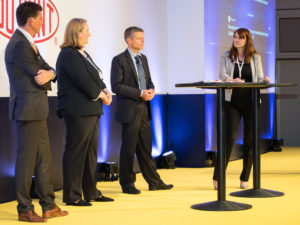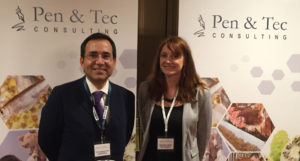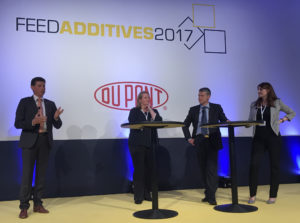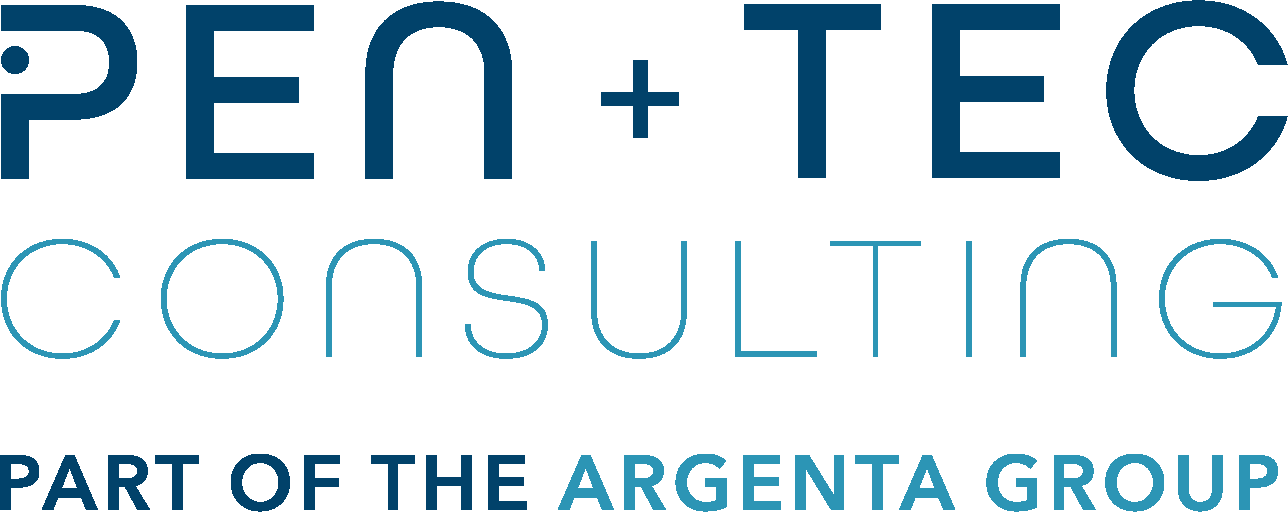Top tips for achieving a feed additive approval – Q&A at Feed Additives 2017
Posted 19 October, 2017
Dr Hannah Lester was invited to moderate the Panel Discussion on “Sharing Experiences of Regulatory Processes and Policies” at the Feed Additives 2017 conference, with a focus on how applicants can work smarter and be more efficient during the EU registration processes.

Hannah opened the discussion by asking the panellists to clarify which EFSA guidance documents applicants should follow, and what would the implications be if an applicant submitted studies conducted according to the old EFSA guidance after the new guidance had been adopted. One of the remarks was that EFSA should not expect applicants to re-do studies that do not follow the new guidance if conducted before adoption of the new guidance.
Hannah also asked the panel for their top tips for a successful feed additive registration:
- Regulatory advice from the start: Seek regulatory input/advice at early stages of product development to improve regulatory success rates and avoid delays.
- Get the study design right: Plan all studies carefully, particularly efficacy studies, and follow current EFSA guidance documents to ensure compliance. This will save time, energy and resources.
- Preparation and planning: Preparation and planning at the early stages of a project will minimise delays and that corner-cutting is not advised. In addition, Pen & Tec advises to involve R&D, regulatory and commercial departments at project initiation, and to continue iteration with these stakeholders through the project life to (successful) EU approval. The PTRC&S (Probability of Technical, Regulatory & Commercial Success) is vastly improved when this key “trinity” is involved in critical decisions, and agrees major changes in project direction due to unforeseen problems.
- Keep up to date: Track new EFSA guidance documents, and apply them when in force.

Several questions were asked by audience members, which the panel did not have time to answer. Pen & Tec’s regulatory team have addressed the following questions raised during the panel discussion:
Q: How do new materials in the Register eventually get listed into the Catalogue? Who drives the updates to the Catalogue?
Pen & Tec: This is covered in the feed regulation, Regulation (EC) Nº 767/2009. Feed materials that are not listed in the Catalogue of Feed Materials can be listed in the Feed Materials Register. The Catalogue of Feed Materials is updated periodically, most recently as Commission Regulation (EU) 2017/1017. Amendments may be proposed by appropriate representatives of the EU feed business sector such as FEFANA, FEFAC or other industry organizations, as well as by Member State competent authorities. Amendments are debated and adopted by the EU Commission and Member State delegates in SCOPAFF Comitology (Standing Committee on Plants, Animals, Food and Feed, Animal Nutrition Section), resulting in the updated regulations mentioned above.
Q: In your experience, do EFSA give genuinely useful pre- or post-submission meetings?
Pen & Tec: Due to resource limitations, EFSA do not provide the opportunity for official, detailed pre-submission discussions. However, EFSA offer a web-based Help Desk service and EFSA Scientific Officers often give informal, non-binding advice by e-mail or telephone. EFSA also offers minuted teleconferences to applicants at critical stages of dossier review, post-submission. Currently, such post-submission dialogue with EFSA is limited and only allowed at specific time points, e.g. to request clarification after a clock-stop or after the adoption of an opinion. This can be useful if you ask the right questions!
On the other hand, the EU Commission will respond to requests for guidance/advice on borderline or novel feed products pre-submission, including pre-submission meetings. The EU Commission also accepts to meet applicants post-submission, usually to discuss options after an inconclusive EFSA opinion.
Elsewhere, the European Medicines Agency (EMA) allow applicants to seek advice pre-submission, which is very helpful, though charged via EMA fees. The US FDA will also meet applicants to discuss pre-submission proposals for US dossiers.

Q: Can we claim phytobiotic feed additives?
Pen & Tec: Phytogenic feed additives (phytobiotics or botanicals) are a hot topic at the moment, due to discussions about their mode/s of action, and naturally-present substance/s of potential toxicological concern, also present in many common foods, herbs and spices. The Commission is still considering a large number of botanically-derived flavouring compounds and currently there is an effort to draft a guideline to distinguish between plant-based feed materials and feed additives. There are also reports that a new ‘phytogenic’ group will appear as a spin-off from the flavours consortium, which may consider the functionality of plant extracts separately and may lead to a new functional group…..We will have to wait and see!
Q: Given the time needed to perform studies, it sounds impossible to keep up with EFSA guidance evolution on a given dossier. Thoughts?
Pen & Tec: We recognize that it is difficult to keep up with EFSA, especially for applicants with relatively few dossiers underway, or small regulatory teams. Several new EFSA guidance documents were adopted at the EFSA FEEDAP plenary meeting on 27 September 2017. These were published on 17 October 2017. During that FEEDAP meeting, which Pen & Tec attended as observers, EFSA encouraged applicants to start following the new guidelines as soon as possible, even though transition periods are foreseen – typically 6 months. We believe that EFSA will be flexible for some time, provided that the applicant supplies appropriate justifications for any deviation from EFSA guidance. Some indications of EFSA flexibility can be found in the outcome of EFSA’s public consultation, also published.
The last EFSA guidances date from 2008-2012 so it was time for an update, especially since EFSA is implementing certain new requirements agreed during FEEDAP Plenary meetings but not yet reflected in published guidance documents. Pen & Tec has indicated to EFSA that it is not good practice to have EFSA guidance dispersed over FEEDAP Plenary meeting minutes and various EFSA guidance documents. EFSA have tried to address this issue with the new guidance documents, for example the draft guidance on characterization of micro-organisms, which draws together the main elements in the quality and safety of feed additives based on micro-organisms.
Q: Is it time to shake up structure of EFSA expert panels? Hire professional EFSA scientists to review – leading to consistency of reviews?
Pen & Tec: This is an interesting idea! EFSA have tried to expand the pool of experts and have limited the duration of service of experts on a given EFSA Panel, presumably to avoid negative effects, such as “group think”. On the other hand, the current practice of refreshing EFSA panels every three years, when 7 of 21 experts on each Panel are replaced, leads to major questions from new experts, which is unfair for applicants and dossiers that had passed initial EFSA assessment, pending minor questions. In our opinion, EFSA is unlikely to welcome the abolition of the independent experts on EFSA Panels, and EU Member States seem to prefer an independent EFSA that takes responsibility for food chain safety evaluations and opinions.
However, a major problem has been that EFSA’s conflict of interest policy prevents the best experts working in those areas of expertise, since in the modern world, most experts acquire their skill set largely through working on industry-funded research projects. We believe that, whereas it is of utmost importance that EFSA assessments are objective and based on good science, a balance must be found to allow industry-acquired expertise to contribute to EFSA’s work.
Q: If I have a useful and safe product that I propose to EFSA as an additive, but the dossier is not recognised, what then is the status? Is it a feed material?
Pen & Tec: The definition of a feed material is different to that of a feed additive. Bear in mind that the product cannot be a feed additive and a feed material at the same time, and that veterinary legislation takes precedence over feed legislation. The EU Commission legal services and Comitology are involved in deciding whether a dossier is within the scope of the feed additive regulation. Poorly-written dossiers submitted by inexperienced applicants often encounter avoidable difficulties by presenting the product as “veterinary” in nature. Hence, Pen & Tec recommends applicants to take “expert advice” early in the project, and if consulting the EU Commission on the legal category, present appropriate supporting arguments for your case.
